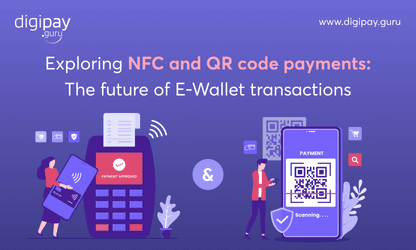Digital currencies, or virtual currencies, are digital or virtual forms of money that use cryptography for security. They are decentralized and operate independently of central banks or governments. Bitcoin, the first and most well-known digital currency, was created in 2009 by an anonymous individual or group using the pseudonym Satoshi Nakamoto.

Since the creation of Bitcoin, a growing number of digital currencies have been developed. Some notable examples include Ethereum, Ripple, and Litecoin. These currencies have gained increasing attention and adoption over the past decade, with the total market capitalization of digital currencies namely bitcoin reaching over $1.28 trillion in 2021.
This blog post will explore the rise of digital currencies and their potential impact on traditional banking. It will examine the factors driving the growth of digital currencies, the changes that may occur to financial institutions' business models, and the potential challenges and opportunities for banks in the face of this emerging trend.
Additionally, the blog post will also cover the current regulatory landscape and potential future developments in government oversight of digital currencies.
The rise of digital currencies
The use of digital currencies has been steadily increasing over the past decade. According to a report by Cambridge Center for Alternative Finance, there were an estimated 35 million unique digital currency users in 2021, with this number expected to continue to grow. In addition, a growing number of businesses, both online and offline, have begun to accept digital currencies as a form of payment.
Apart from that, the digital currency market is dominated by a few key players. Bitcoin, the first and largest digital currency, has a market capitalization of over $421.35 billion in 2023. Other major players include Ethereum, Ripple, and Litecoin, each with market capitalizations of over $100 billion.
Moreover, the growth of digital currencies is driven by several factors. One major factor is increased interest in decentralized and trustless systems, as digital currencies operate independently of central banks or governments.
Additionally, the growth of digital currencies has been driven by increasing recognition of their potential as a store of value and means of payment, as well as the increasing ease of buying and using digital currencies.
The growing adoption of digital currencies by both individuals and businesses, as well as the increasing number of options for storing and using digital currencies, has also contributed to their growth.
Advantages of Digital Currencies for Traditional Banks
The popularity of digital currencies has been rising due to the myriad advantages that it provides. Some of the major advantages of digital currencies are mentioned below:

Speed and efficiency
Fintech solutions like digital currencies have transformed the banking industry as it uses decentralized systems and blockchain technology, which allows for faster and more efficient transactions.
Transactions can be processed 24/7 without the need for intermediaries, such as banks. This means that transactions can be completed in a matter of minutes, rather than the days or weeks it can take with traditional banking.
Read More: Top fintech solutions transforming the banking industry
Decentralization and security
Digital currencies operate on a decentralized system, meaning that no single entity controls the currency. This decentralization also makes digital currencies more secure as there is no central point of failure. Transactions are recorded on a public ledger (the blockchain) which is secure and transparent.
Lower transaction costs
Digital currencies can have lower transaction costs compared to traditional banking. This is because digital currencies do not require intermediaries such as banks, which can charge high fees for services like currency exchange and wire transfers.
Additionally, digital currencies can also eliminate the need for physical currency, which can be costly to produce and distribute.
Improved customer experience
The use of digital currencies has resulted in improved customer experience. Such currencies are renowned for their unparalleled convenience and seamlessness when used to carry out transactions.
Unlike traditional banks which come with difficult processing times, prolonged paperwork, and limited banking hours, digital currencies deliver instant and swift transactions. Through this, they present customers with a persuasive value proposition that traditional banks are finding challenging to reach.
New revenue streams
Traditional banks can tap into new revenue streams as digital currencies become more prevalent.
This means that banks can leverage the growing popularity of digital currencies by extending their customer base to include digital currency enthusiasts and businesses preferring digital currencies for their transactions. By doing so, they can create a more diverse customer base, while also boosting revenue streams.
The potential impact of digital currencies on traditional banking
Digital currencies have the potential to greatly impact traditional banking. One of the most significant ways is by providing an alternative to traditional banking systems, which could lead to a decrease in the need for traditional banks.
Digital currencies allow for peer-to-peer payment app transactions without the need for intermediaries such as banks. This could lead to lower transaction fees and faster, more efficient transactions.
Changes to financial institutions' business models
The rise of digital currencies has the potential to significantly disrupt traditional banking business models. Digital currencies operate on decentralized systems, which do not rely on the intermediation of financial institutions and can be done through various digital payment apps.
This could lead to disintermediation, where financial institutions are removed from the process of intermediating transactions. This could also lead to a reduction in revenue for traditional banks, as they would no longer be able to charge fees for services such as currency exchange and international money transfers.
Effects on consumer behavior and transaction processes
The use of digital currencies could lead to changes in consumer behavior and transaction processes. Digital currencies allow for faster, cheaper, and more secure transactions, which could lead to increased adoption by consumers.
This could also lead to changes in the way transactions are processed, as digital currencies operate on decentralized systems, which do not rely on the intermediation of financial institutions.
Boosting cross-border transactions
Digital currencies and other innovations in payment systems, such as mobile money and blockchain technology, have the potential to revolutionize the way we make transactions.
They offer the possibility of faster, cheaper, and more efficient domestic and cross-border transactions, making it easier for people to access financial services and participate in the global economy.
For example, by using digital currencies, people living in remote or rural areas, who may not have access to traditional banking services, can now easily transfer money to relatives or make payments for goods and services via digital banking. Thus, financial technologies like digital currencies are transforming international remittances.
Hence, digital currencies have the potential to greatly impact traditional banking by providing an alternative to traditional banking systems, increasing financial inclusion, and changing the way we think about money and financial systems.
However, the extent of this impact is still uncertain, and more research and development are needed to fully understand the implications of digital currencies on traditional banking.
Potential challenges and opportunities for banks
The rise of digital currencies poses both challenges and opportunities for traditional banks. On one hand, digital currencies could lead to disintermediation and a reduction in revenue for banks.
On the other hand, banks could explore ways to integrate digital currencies into their existing business models, such as offering cryptocurrency digital wallet solutions or facilitating the exchange of digital currencies.
Additionally, some banks have started to research and invest in digital currencies and blockchain technology, which would allow them to stay competitive in the ever-changing market.
Government regulations and oversight
Current regulatory landscape
The regulatory landscape for digital currencies varies by country. Some countries, such as Japan and South Korea, have embraced digital currencies and have implemented regulations to support their growth.
Other countries, such as China and India, have taken a more cautious approach and have placed restrictions on the use and trading of digital currencies. In the United States, digital currency regulations are still evolving, with different states and federal agencies taking different approaches.
The U.S. Treasury's Financial Crimes Enforcement Network (FinCEN) has issued guidance on how existing regulations apply to digital currencies, while the Securities and Exchange Commission (SEC) has issued guidance on how digital currencies and initial coin offerings (ICOs) are considered securities.
Future developments
As the use of digital currencies continues to grow, government regulations and oversight will likely continue to evolve. Some experts predict that governments will eventually implement regulations to prevent fraud and financial crimes through this kind of payment, as well as to protect consumers.
Additionally, some governments may consider issuing their digital currencies, which could lead to increased competition for existing digital currencies.
Conclusion
In conclusion, the rise of digital currencies has been a significant trend in the past decade, with increased market capitalizations. The use of digital currencies has been driven by factors such as increased interest in decentralized systems, increased recognition of digital currencies as a store of value and means of payment, and the growing adoption by both individuals and businesses.
The rise of digital currencies has the potential to significantly disrupt traditional banking business models, leading to disintermediation and a reduction in revenue for traditional banks.
The use of digital currencies could also lead to changes in consumer behavior and transaction processes, as they allow for faster, cheaper, and more secure transactions.
Cryptocurrencies have the potential to revolutionize cross-border transactions by providing faster, cheaper, and more efficient options. With the current regulatory landscape and potential future developments in government oversight, the future of digital currencies and their impact on traditional banking remains to be seen.
Moreover, we at DigiPay.Guru can enhance your experience of digital currency transactions with its advanced cryptocurrency wallet solution with features including QR payments, two-factor authentication, access to view exchange rates in real-time, wallet backup, transaction history, and much more.




